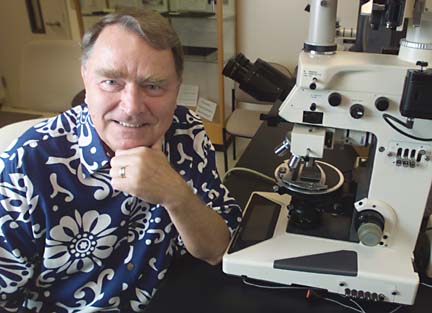
RICHARD WALKER / RWALKER@STARBULLETIN.COM
The International Mineralogical Association is honoring Klaus Keil, of the University of Hawaii Institute of Geophysics and Planetology, for his role in discovering a new mineral in 1967.
Mineral is named
for UH scientistThe extraterrestrial mineral will be called
keilite to honor its discoverer, Klaus Keil
A new type of mineral discovered in extraterrestrial fragments of asteroids has been named keilite in honor of Klaus Keil, director of the University of Hawaii Institute of Geophysics and Planetology.
Two scientists in Japan and one in Canada submitted the name to the Commission on New Minerals and Mineral Names of the International Mineralogical Association in recognition of Keil's "outstanding research on the mineralogy and petrography of chondritic meteorites."
Keil and his colleagues discovered 12 new minerals in meteorites in 1967, calling them "niningerite."
However, in preparing the description of niningerite for the International Encyclopedia of Minerals, Masaaki Shimizu, of Toyama University, and Joseph Mandarino, of the Royal Ontario Museum, found the published data actually covered two species of minerals: niningerite, which has more magnesium than iron, and an unnamed iron-dominant analogue of niningerite.
Keil provided Shimizu, Mandarino and Hideto Yoshida, of the University of Tokyo, with more material which allowed them to make analyses to describe the new mineral.
The grains were so small that most of the physical properties of the keilite material could not be determined when he and his associates described niningerite, Keil said.
Both the new mineral, found in several meteorites, and the name have been approved by the Commission on New Minerals and Mineral Names.
Describing keilite in the Canadian Minerologist, Shimizu, Yoshida and Mandarino said it "is an example of a mineral whose description has been in the literature for many years 'masquerading' as a different mineral, in this case niningerite.
"Optically, it would be difficult to differentiate keilite from niningerite," they wrote.
Keil said the mineral bearing his name "is the iron-dominant analogue of niningerite ... so it's gratifying that one end member I named, and then someone else named the other end member for me."
He said the new mineral is very significant because "it is unadulterated primitive solar system material" that reveals conditions when they were formed in asteroidal meteorites.
"They have the same makeup as they did 4.57 billion years ago when they formed from solar nebulae," with a relatively high abundance of hydrogen and lack of oxygen, he said.
Minerals found in extraterrestrial rocks would not form on Earth because there is too much oxygen, he pointed out.
Delighted to learn his name will be "in the annals of science forever," Keil said naming minerals "is not just like naming a baby."
He named the minerals he discovered and said "it is a very arduous and complex process."
An extremely detailed research report must be submitted to the Commission on New Minerals and Mineral Names, he said, and it is critiqued by 33 experts to make sure the mineral "wasn't described before, that all properties are named and all questions attacked."
